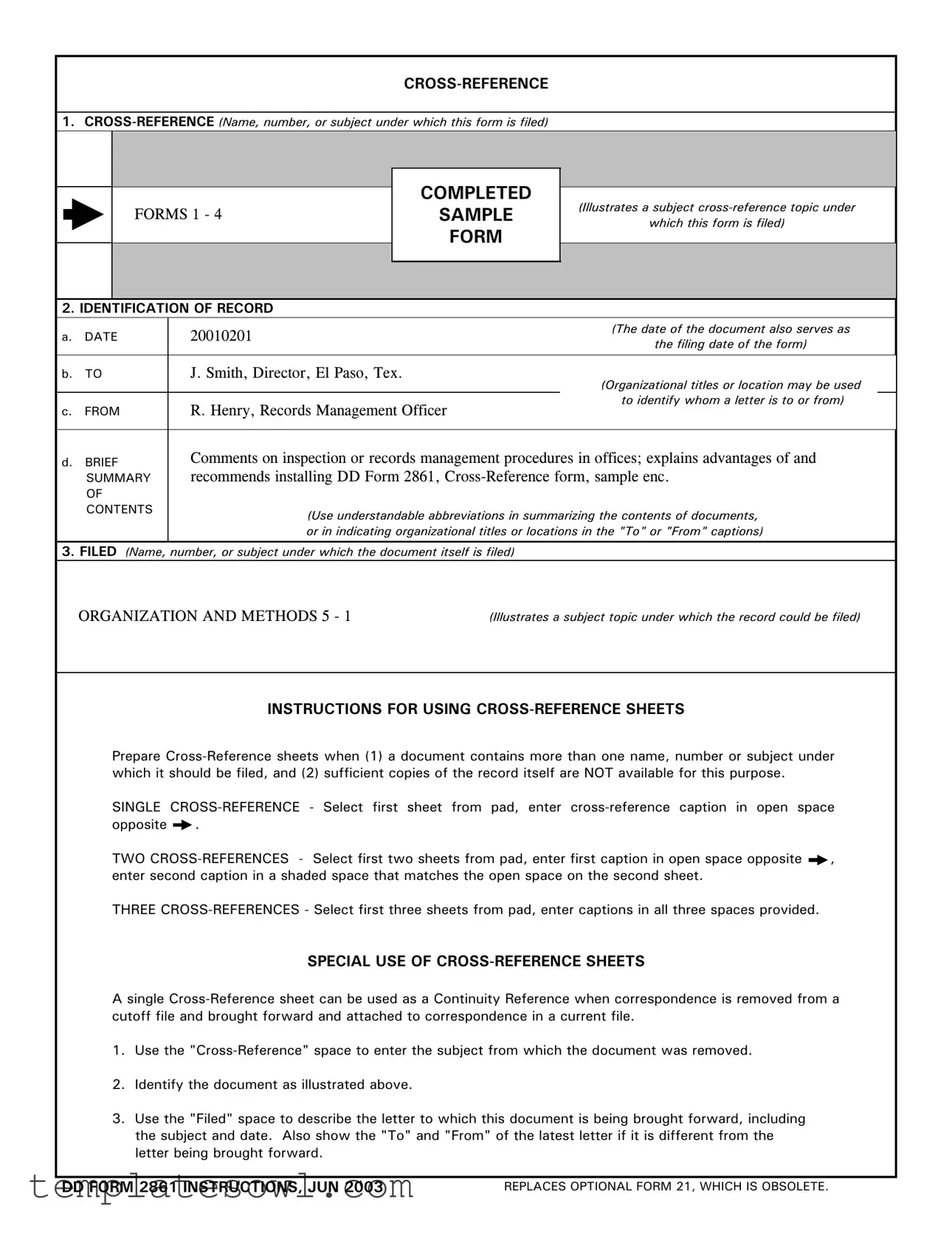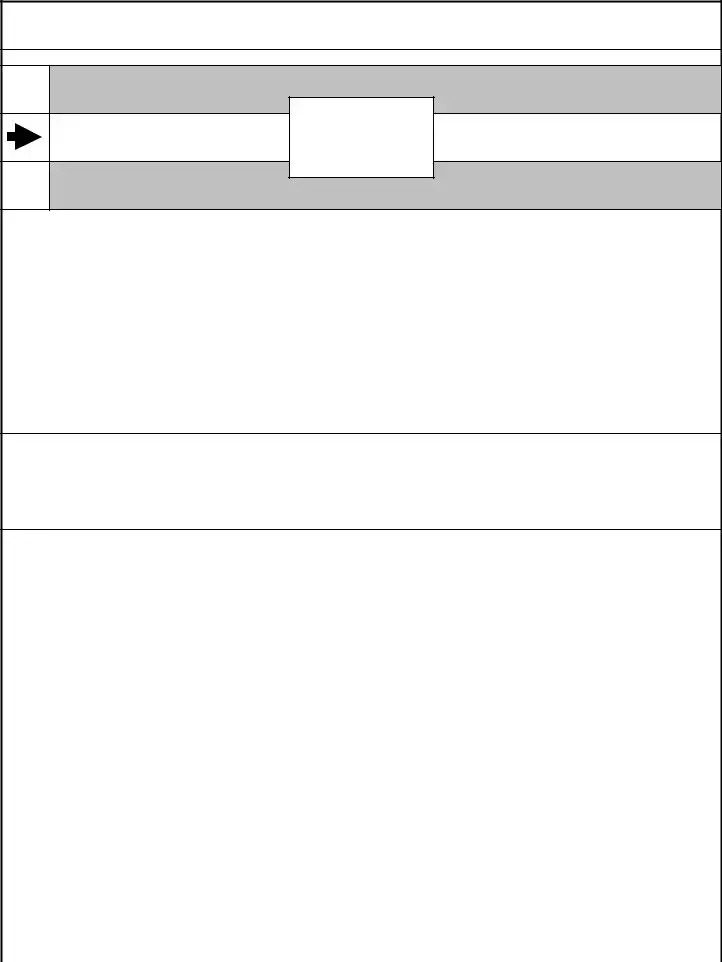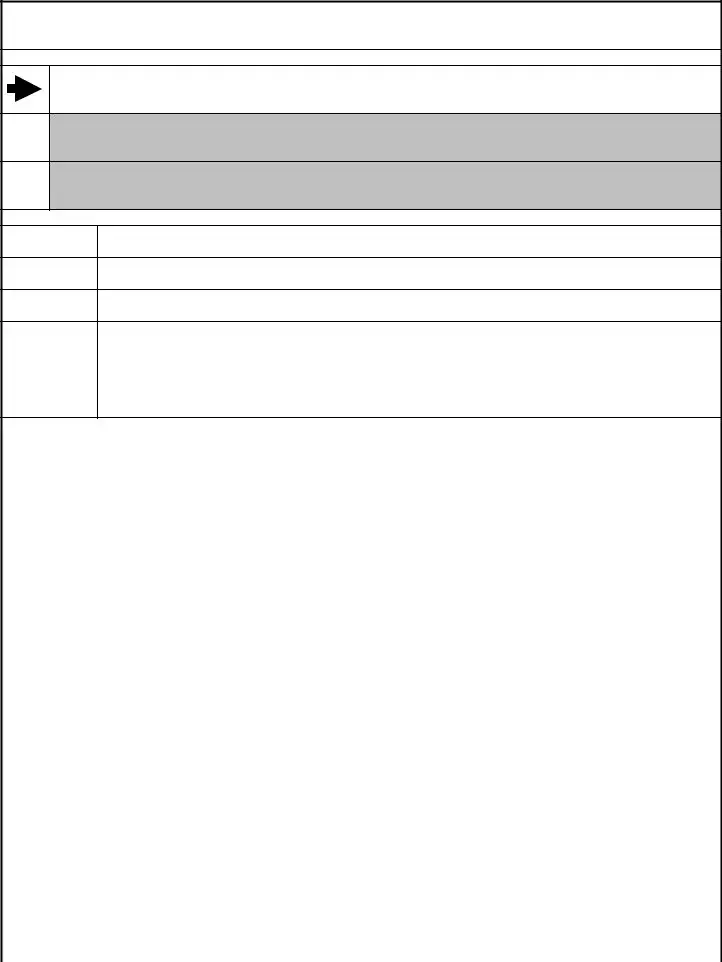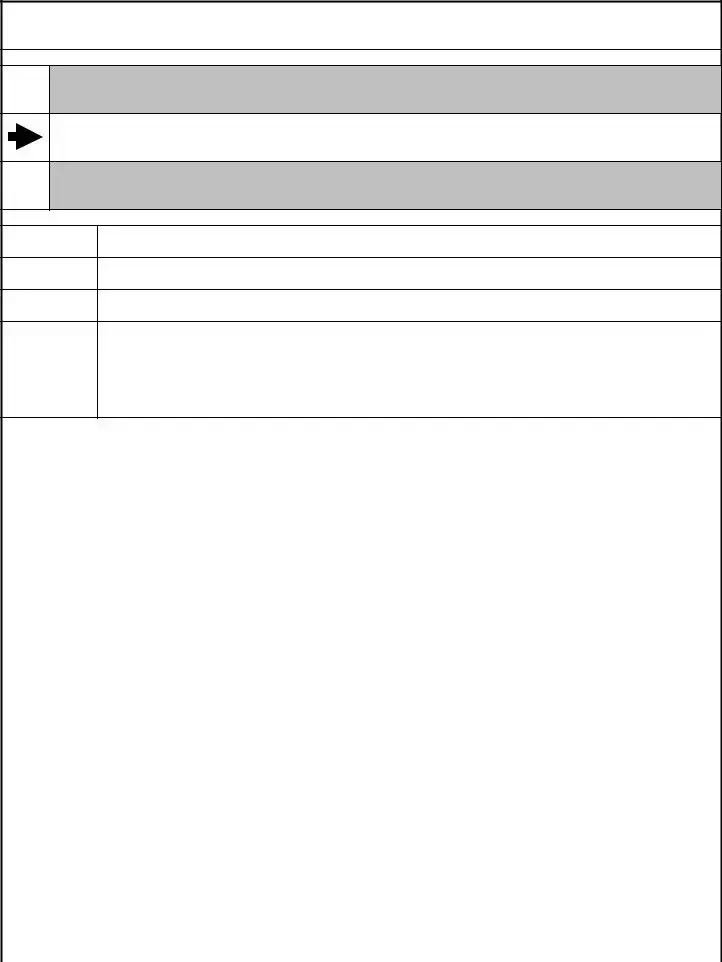CROSS-REFERENCE
1.CROSS-REFERENCE (Name, number, or subject under which this form is filed)
(Illustrates a subject cross-reference topic under
which this form is filed)
2. IDENTIFICATION OF RECORD
a. |
DATE |
20010201 |
|
(The date of the document also serves as |
|
the filing date of the form) |
|
|
|
|
|
|
|
|
|
b. |
TO |
J. Smith, Director, El Paso, Tex. |
(Organizational titles or location may be used |
|
|
|
|
c. |
FROM |
R. Henry, Records Management Officer |
to identify whom a letter is to or from) |
|
|
|
|
|
|
|
|
d. |
BRIEF |
Comments on inspection or records management procedures in offices; explains advantages of and |
|
SUMMARY |
recommends installing DD Form 2861, Cross-Reference form, sample enc. |
|
OF |
|
|
|
|
|
CONTENTS |
|
(Use understandable abbreviations in summarizing the contents of documents, |
|
|
|
|
|
|
or in indicating organizational titles or locations in the "To" or "From" captions) |
|
|
|
|
|
|
3.FILED (Name, number, or subject under which the document itself is filed)
ORGANIZATION AND METHODS 5 - 1 |
(Illustrates a subject topic under which the record could be filed) |
INSTRUCTIONS FOR USING CROSS-REFERENCE SHEETS
Prepare Cross-Reference sheets when (1) a document contains more than one name, number or subject under which it should be filed, and (2) sufficient copies of the record itself are NOT available for this purpose.
SINGLE CROSS-REFERENCE - Select first sheet from pad, enter cross-reference caption in open space
opposite  .
.
TWO CROSS-REFERENCES - Select first two sheets from pad, enter first caption in open space opposite  , enter second caption in a shaded space that matches the open space on the second sheet.
, enter second caption in a shaded space that matches the open space on the second sheet.
THREE CROSS-REFERENCES - Select first three sheets from pad, enter captions in all three spaces provided.
SPECIAL USE OF CROSS-REFERENCE SHEETS
A single Cross-Reference sheet can be used as a Continuity Reference when correspondence is removed from a cutoff file and brought forward and attached to correspondence in a current file.
1.Use the "Cross-Reference" space to enter the subject from which the document was removed.
2.Identify the document as illustrated above.
3.Use the "Filed" space to describe the letter to which this document is being brought forward, including the subject and date. Also show the "To" and "From" of the latest letter if it is different from the letter being brought forward.
DD FORM 2861 INSTRUCTIONS, JUN 2003 |
REPLACES OPTIONAL FORM 21, WHICH IS OBSOLETE. |

GUIDE TO EFFECTIVE CROSS-REFERENCING
An effective cross-reference system should be developed according to definite plans, and not be allowed to grow haphazardly. Essential considerations in a cross-reference system are:
 Written instructions should be prepared and distributed to each person who refers to files for information and to each person who services files.
Written instructions should be prepared and distributed to each person who refers to files for information and to each person who services files.
 The amount of cross-referencing is governed by the needs of persons who call for files data. As in other administrative procedures, the rule of economy also applies in controlling the amount of cross-referencing. A careful balance should be maintained between too little and too much cross-referencing.
The amount of cross-referencing is governed by the needs of persons who call for files data. As in other administrative procedures, the rule of economy also applies in controlling the amount of cross-referencing. A careful balance should be maintained between too little and too much cross-referencing.
 Officials who call for files materials should be able to depend on consistency in the kind and amount of cross-referencing that is performed.
Officials who call for files materials should be able to depend on consistency in the kind and amount of cross-referencing that is performed.
 Cross-references should be sufficiently descriptive to make them completely clear as to the documents they refer to.
Cross-references should be sufficiently descriptive to make them completely clear as to the documents they refer to.
Persons experienced in the field have found the following guides to be useful in developing effective cross-reference systems:
GUIDES
1.CONSIDER THE NEEDS OF PERSONS REFERRING TO THE FILES. The needs of persons who call for materials from the files vary. Therefore, these individuals should take an active part in indicating the references that will be needed. For example, based on their experience and understanding of programs, they are best able to show the files employees the materials that should be cross-referenced to policy, precedent, or other category.
2.BALANCE COST AGAINST USE. The quantity of cross-references which should be made must be determined by relating cost (time) required to prepare and file cross-referenced forms to the time that would be required to search a file if no cross-references existed. For example, experience shows that as much as 5 to 10 minutes may be required to prepare, sort, and file one cross-reference. On the other hand, some searches for records for which there are no cross- references, may take 1 hour. It should be borne in mind that many cross-reference sheets are never referred to after being prepared and filed.
3.USE EXTRA COPIES OR "QUICK" COPIES WHERE
POSSIBLE. Extra copies or copies produced on quick-copy machines are the best kind of cross- reference, since they are complete in themselves, and they avoid writing additional pieces of paper. Many procedures can be arranged to get extra copies, at very low cost, of material that will be cross-referenced. Cost is always checked before going to extra or quick copies.
PRACTICAL PURPOSES SERVED
1.BETTER RESULTS FROM TIME AND EFFORT are obtained. Certain documents must always be cross- referenced, while other papers need never be cross-referenced. For example, Congressional corres- pondence is usually cross-referenced by sender's name, by subject, and often by constituent's name. On the other hand, personnel transactions, vouchers, and certain reports usually need no cross-referencing.
a.SHARPER CRITERIA are available to files personnel. Establishment of firm policies as to what does and what does not require cross- referencing, permits files personnel to process large volumes of material in bulk, without reading every document to decide whether or not cross-referencing is needed.
b.PAPERWORK "BY-PRODUCTS" are used to simplify the task of making cross-references. Full use is made of extra copies, quick copies and similar materials.
2.MORE RELIABLE FILES SERVICE is provided. The system is responsive to the needs of persons asking for materials from the files. Excessive cross- referencing is avoided, yet sufficient cross-references are in the files to assure fast, accurate, and consistent files reference service.
The foregoing guides have been developed by the National Archives and Records Service, Office of Records Management, General Services Administration.
DD FORM 2861 INSTRUCTIONS (BACK), JUN 2003
CROSS-REFERENCE
1.CROSS-REFERENCE (Name, number, or subject under which this form is filed)
2. IDENTIFICATION OF RECORD
a.DATE
b.TO
c.FROM
d.BRIEF SUMMARY OF CONTENTS
3.FILED (Name, number, or subject under which the document itself is filed)
|
|
|
|
DD FORM 2861, JUN 2003 |
Page 1 of 3 Pages |
CROSS-REFERENCE
1.CROSS-REFERENCE (Name, number, or subject under which this form is filed)
2. IDENTIFICATION OF RECORD
a.DATE
b.TO
c.FROM
d.BRIEF SUMMARY OF CONTENTS
3.FILED (Name, number, or subject under which the document itself is filed)
|
|
|
|
DD FORM 2861, JUN 2003 |
Page 2 of 3 Pages |
CROSS-REFERENCE
1.CROSS-REFERENCE (Name, number, or subject under which this form is filed)
2. IDENTIFICATION OF RECORD
a.DATE
b.TO
c.FROM
d.BRIEF SUMMARY OF CONTENTS
3.FILED (Name, number, or subject under which the document itself is filed)
|
|
|
|
DD FORM 2861, JUN 2003 |
Page 3 of 3 Pages |


 .
. , enter second caption in a shaded space that matches the open space on the second sheet.
, enter second caption in a shaded space that matches the open space on the second sheet.
 Written instructions should be prepared and distributed to each person who refers to files for information and to each person who services files.
Written instructions should be prepared and distributed to each person who refers to files for information and to each person who services files. The amount of
The amount of  Officials who call for files materials should be able to depend on consistency in the kind and amount of
Officials who call for files materials should be able to depend on consistency in the kind and amount of 


